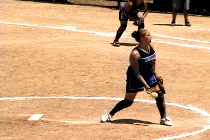|
by Gerald Warner,
Softball Pitching Instructor


We receive many questions regarding control of pitches…and
the most frequent is correcting the problem of consistently throwing
low, or low and inside. It’s
a problem that is pretty typical for younger girls...and
sometimes even those who are more experienced. It usually is
attributable to a being “off-plane” during the arm swing, the
pitcher's closing rotation, or when a pitcher strides too far off
the power line (for a right-hander, that
means stepping left of the power line).
When a pitcher throws pitches inside...or inside and low...to
a same-side batter, it is likely one or more of the
problems:
1) SIDE STEPPING
- Young pitchers who "side
step" often throw
low (and usually
inside). Right-handed pitchers who step LEFT of the
line tend to throw to the RIGHT of the
plate (similarly, lefties who step too far
right, often throw to the left)
.
2) "SNAPPING" THE
RELEASE – Some people, even
coaches, sometimes tell a young pitcher to "snap your wrist when you
release the ball". Therefore, pitchers often focus
too much on “snapping”, and consequently have an early or late
forward wrist movement. I and most other
softball pitching instructors who have good track records of
helping pitchers develop good speed do not focus on an
intentional wrist-snap...especially in their early years of
pitching. Instead, we teach pitchers to use the wrist
snap as a natural or intuitive action as part of the arm whip...keep
the wrist loose and slightly bent back on the
downswing, and the wrist will drive forward automatically at the
release.
3) SLOW TRUNK ROTATION
- At the release point of
the ball, a pitcher gets maximum torque (and
therefore speed) if her shoulders are most of
the way closed (facing
the catcher) and her hips are
no more than halfway closed. For a right-handed
pitcher, if the right side comes around too late, it invariably
causes a low inside
pitch.
(Similarly, if a left-handed pitcher closes late, the pitch often
goes to the left side of the plate).
We encourage a pitcher to
always "use your entire body...not just your arm" to pitch the
ball. That helps her
have a better-timed trunk
rotation.
4) TOO
SHORT OF A STRIDE - Although a comparatively
small percentage of successful pitchers use the short-stride
"Stepping Style" method, the majority are "Leap-and-Drag"
pitchers. Leapers who stride considerably
shorter than their height often consistently throw low.
The solution, obviously, is to make certain the length of the stride
is 90% to 120% of the pitcher’s
height.
5) LEANING FORWARD AT THE
RELEASE - The bend-over habit
typically causes a younger or beginning pitcher to slow down
her pitch, release in front of her body, and consequently throw
high pitches. However, when an older more
experienced pitcher becomes more aggressive and adds speed to
her fastball, if she bends forward at the release, her pitches often
go low and into the dirt.
6) FAULTY BACK SWING -
A pitcher that uses a back
swing prior to the start of the forward rotation often allows the
arm to swing "off-plane". If the arm swings to the
middle of the back (instead
of on the power line plane), that can throw the
entire forward rotation on a right-tilting plane, causing consistent
inside pitches.
7) PRE-PITCH 'FOCUS
POINT' - Repeated inside pitches
can often be corrected by changing the "focus point"...the spot
where the pitcher is looking as she prepares to start her
wind-up and during the delivery. Most younger pitchers
will be looking at the catcher's mitt. So if she is
throwing right, instead of staring at the catcher's mitt, look
further left...perhaps to the catcher's right knee...all the time
while she is standing on the rubber and through
her wind-up. Tell her "You aren't trying to throw
there; you're just looking there as you
pitch".
If
side-stepping mentioned above is the problem, have her
repeatedly practice landing with her toe on the power
line. If you haven't already read it, go to the "Power
Line" page in the 1st & 2nd Year Pitchers section
of this website.
If
a slow closing rotation is the problem, use the "9 o'clock
drill"
(stand in the "open" position perpendicular to the catcher, glove hand pointing toward the
plate, throwing arm straight up in the
air) by pitching full speed and
practicing a good trunk closure
(to
about halfway closed at the point of release) with the
delivery.
If the back swing is the issue, videotape the pitcher
from behind so she can see where the arm is going...discovery of the
problem is 60% of the cure.
This article above can be downloaded and
printed from Microsoft Word

Do you want to reprint this article or use it
on your website or in your newsletter?
As long
as it is not for profit, our only requirement is that you first
notify us, then include the following sentence:
Article by Gerald Warner of
PitchSoftball.com
and include a reference to this
website: www.pitchsoftball.com
If you have questions or
need more information
E-mail us, or
call Pitching Instructor Gerald Warner in Colorado at
(720) 200-4575
PitchSoftball Home Page | About Us | Beginning Pitchers | 1st & 2nd Year
Pitchers | Advanced Pitchers | Coaches and Parents
Recent Questions and
Recommendations | Search by Keywords | 












